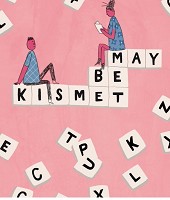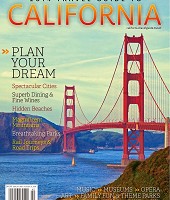
Sunset Magazine: “Carried Away”
Published in Sunset Magazine
by Lavinia Spalding (google+)OZZY IS GIVING ME ATTITUDE--bumping against my pack, nosing ahead, blowing his semisweet-fermented breath in my face. I nudge him on the chest to keep him behind me as I inch down the steep sandstone, but he clearly has personal-space issues. I chose Ozzy this morning based on stature--as we were the two shortest members of our respective groups, I presumed we'd get along. But I'm having llama drama.
Since moving to Boulder, I'd been mesmerized--and overwhelmed--by the kaleidoscopic, seemingly infinite vistas. But during that trip, cocooned in a sleeping bag deep inside a canyon, the landscape changed, becoming close and real and personal.
My tactic is simple: I trade up. I ask Dan for his llama, Dagwood. And 10 minutes later, as Dagwood and I breeze down a thin, slick track, I feel only minimal guilt when I overhear Dan trying to reason with Ozzy. "Seriously, bro," he's saying. "Stay behind me."
Just yesterday we learned that llamas--members of the camelid family--don't respond to vocal commands. "They're a lot like cats," said our guide, BJ. "Only not your cat. They're like someone else's cat." In other words, attention-averse and just barely tolerant of the human race. BJ also dispelled a popular misconception: Llamas don't spit at people unless improperly trained. (They do spit at one another.) And no, you don't get to ride them.
IT'S EARLY OCTOBER, and I'm in the Grand Staircase-Escalante National Monument in southern Utah, with my husband, two sisters-in-law, eight llamas, and BJ Orozco, the laid-back owner of the llama pack-trip outfit Llama2Boot. The monument was designated by President Clinton in 1996 and is run by the Bureau of Land Management, and it is incomprehensibly vast and rugged: nearly 1.9 million acres of golden buttes and vermilion cliffs, slot canyons, mesas, monoliths, dinosaur bones, and Native American ruins--plus plenty of water, wildflowers, and cottonwoods.
We're here because 14 years ago, BJ and I waited tables together at my sister's restaurant, in nearby Boulder, a tiny town right at the monument's edge. BJ moonlighted as a llama-packing guide then, and I joined him on a four-day camping trip with another friend. We borrowed two llamas-in-training to carry our stuff, and at night BJ pointed out constellations and told stories of Everett Ruess, the young poet and artist who explored this area with his burros in the 1930s but mysteriously disappeared. Since moving to Boulder, I'd been mesmerized--and overwhelmed--by the kaleidoscopic, seemingly infinite vistas. But during that trip, cocooned in a sleeping bag deep inside a canyon, the landscape changed, becoming close and real and personal.
Today I live in San Francisco, but Boulder remains my second home. With a population of just 200, this area is part of the West that's still wild. The Escalante Canyons, where we're hiking, was the last place in the country to be explored and mapped. The Escalante River--which we'll cross many times over the next few days--was the last major river discovered in the continental United States. Boulder was the last town in the nation to receive its mail by mule; electricity didn't arrive until 1947; and just five years ago, there was zero cell service.
View the complete article (PDF format)
Going: New Orleans, The Southern US City Where Jazz Was Born
Parents: I Grew Up in a Haunted House—Here’s What I Tell My Child About Ghosts
AFAR: Seoul Food
Off Assignment, Letter to a Stranger: “To the Shopkeeper in Fez”
The Bold Italic: “Working Three Jobs Nearly Killed Me”
AirBnB Magazine: “So I Slept in a ...Cave”
AAA Westways Magazine: “Korean Encore”
AFAR.com: “Everything You Need to Know About Jazz Fest”
AFAR.com: “Get Beyond the Beads: The 101 on Mardi Gras Throws”
AFAR.com: “The Art of Eating Crawfish in New Orleans”
AFAR.com: “Find New Orleans’s Soul at These 6 Mini-Museums”
Ms. Magazine: “Politics is on the Menu at Hell’s Backbone Grill”
AirBnB Magazine: “New Orleans for the Celebratory”
Off Assignment, Letter to a Stranger: “To the one who was supposed to get away”
Off Assignment, Letter to a Stranger: “To Old Johnny”
Viator: “Coming Full Circle”
World Hum: “How Korean Karaoke Changed my Life”
Independent Bookstore Day’s anthology: “My Lesson from Hell”
-
The New York Times, Modern Love: “Goodbye, My Fantasy Man”
I wasn’t willing to settle for less than kismet. But chasing a romantic illusion nearly kept me from finding love. -- The night I agreed to try online dating, I told my roommate Meghan I hoped I wouldn’t meet anyone because that wasn’t the kind of story . . .
-
River Teeth: A lot of Tomorrows
We are at the dinner table when my young son asks, “The day after a lot of tomorrows, will we build a treehouse?” I want to scoop him in my arms, this boy so eager and fresh, so tall his forehead meets my shoulder. If I could, I would lift his body above . . .
-
AFAR: Seoul Food
I still clearly remember my first meal in South Korea. I had just arrived in the country, fresh out of college and ready to begin a job teaching English. My new boss had whisked me from the airport to a barbecue restaurant, where I’d watched in panic as . . .
-
The New R&R
. . .




























